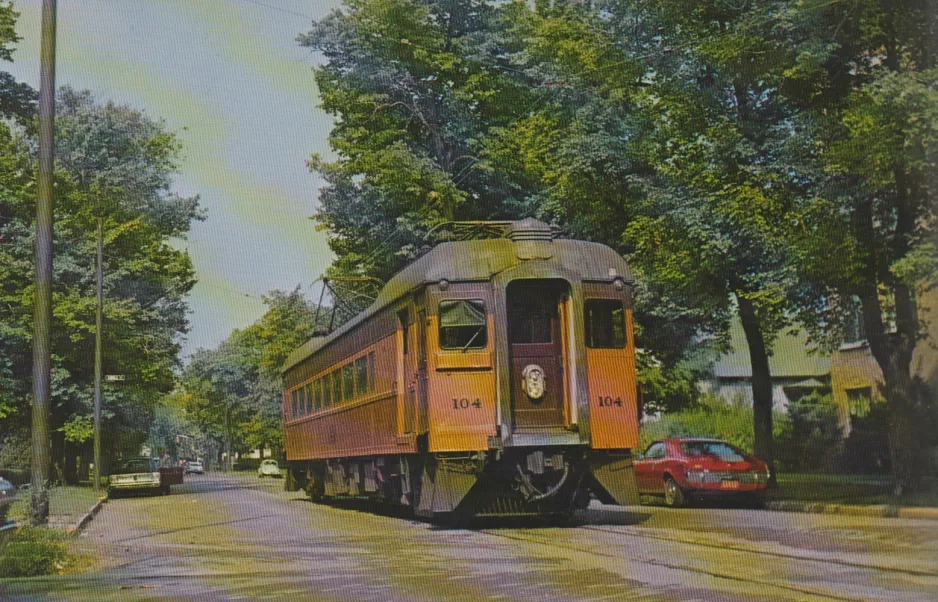Postkort: Chicago motorvogn 104 på Michigan Street (1969)
Lokalitet: Michigan Street.
Arkiv: Henrik Boye.
Fotograf: Gary Allan.
Udgiver: Lyman E. Cox.
Dato: 1969.
By: Chicago (USA).
Billedet viser
Chicago Transit Authority (CTA)
Nedlagt
Chicago motorvogn 104, serie 102-105.
Beskrivelse
In 1969 two kinds of railroads in the U.S.A. were decidedly rare: those with electric locomotives, and those which operated 1-car interurban service. By such standards the Chicago South Shore and South Bend Railroad was most unusual; it qualified in both categories. Moreover, it owned some of the most modern and powerful locomotives for its freight which had decimated similar enterprises, the Chicago South Bend was a healthy living transportation anachronism, and there just wasn't anything else quite like it in the nation.
Its interurban motor car No. 104, seen here running along Michigan Street at the end of the line in South Bend, Indiana, was but one example of the South Shore's progressive capabilities. What was more surprising was that neither this car, nor moost of the railroad's motive power, was new or of recent manufacture. Exxcepting its three huge GE 5600-hp. 2-D+D-2's, its motive power had seen years of previous service on other railroads, while itspassenger cars had undergone almost continuous modifications over a four-decade period.
Car 104 was one of three (102, 104, 105) baggage-passenger cars which had been rebuilt in World War II times. The original 60-ft. car body wascut into two pieces, and a 17½ ft. section was spliced between them, making the car 77½-ft. long. The baggage compartment occupied 111/4 feet, the remainder being devoted to seating for 64 passengers. Four other cars (100, 101, 103, 106) were similarly rebuilt, the pricipal difference being the installation of 68 seats by making the baggage space three feet shorter. Long double windows replaced the small single ones, and flourescent lamps furnished greatly improved interior illumination. Thereconditioned cars were air-conditioned, authough, oddly enough, propane-fuel reciprocating engines drove the refrigerant compressors. These performed satisfactorily for ten years, but were replaced eventually with electrically powered systems.
Ordinary passenger runs between Chicago and South Bend were regularly scheduled at 130 minutes for the 90-mile journey in either direction, with 18 intermediate stops. One train eastbound, however, was due to depart Randolph Street Terminal adjacent to Chicago's Loop secition at 5:18 PM on weekdays, and after making six stations stops en route was expected in South Bend no later than 7:10 PM, for an overall time of 112 minutes. Its westbound counterpart left South Bend at 6:35 AM, and after making 10 stpos hed consumed exactly two hours start-to-stop. Free-running speeds of 70 mph. over jointless rail were part of the routine for these two "Hotshots", as they were called by the railroad's operating personnel. Usually, a regular run commenced at South Bend with one car. One or two more were added in a matter of minutes at the Michigan City, Indiana, shops, 32 miles to the west. Another two or three were added at Gary, Indiana, 31 miles from Chicago, during the station stop there. This flexible procedure was quickly and efficiently executed, and passengers were hardly aware of the westbound additions or the eastbound subtractions.
The original cars (49 with Baldwin-Westinghouse motor trucks, and 15 without motors) had been built in 1926 soon after the Chicago South Shore and South Bend company had taken over the bankrupt Chicago, Lake Shore & South Bend Railroad. They were purchased as part of the multi-million dollar reconstruction program, which included an unusual reelectrification of the system. The Chicago, Lake Shore & South Bend was 1500-volt DC, matching the Illinois Central's suburban electrified lines south of Chicago. The new flexible-cantenary overhead wires were installed without affecting existing operations, and the existing rigid installation was removed without interrupting service. The entire conversion was a remarkably smooth transformation. Afterward, Chicago South Shouth and South Bend trains entered the Chicago downtown area over Illiois Central trackage, and used its stations also, a most advantageous arrangement for both railroads.
Chicago South shore and South Bend Railroad
Jt-532 J6166

Se billedet i høj opløsning. Venligst giv besked hvis billedet benyttes, og indsend gerne dine egne sporvognsbilleder.